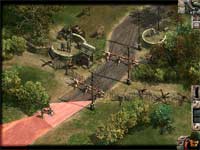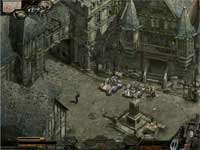I am an impatient soul.
This expresses itself in inconvenient ways when I am playing games that reward patience and timing. In grand strategy games, for example, I’ll carefully marshall my resources, start moving troops into position, and then perhaps six or seven turns too early I’ll get bored and say to myself “Well, maybe if I just send all my tanks rushing in I’ll win.” And, of course, I never do.
This is in part why I don’t like the Metal Gear games at all — they are, by and large, games that reward you for sitting still and doing nothing until exactly the right moment, and that’s just not my thing. As a reviewer, I make a conscious effort to not review those sorts of games.
I’ve made an exception to this rule for Commandos Battle Pack for the Mac. Mostly because, unlike the Metal Gear games, I actually liked it. This review may contain some minor spoilers.
The Battle Pack consists of two games packaged together: Commandos 2: Men of Courage and Commandos 3: Destination Berlin. Both games run well on a late-model Powerbook G4.
One of the best things Commandos has going for it is the plot. All men “of a certain age” will remember a World War II movie called The Dirty Dozen. It’s been emulated and remade several times. The basic idea is “group of misfits who are too tough and independent for the regular army take on suicidal missions and, through stealth, ingenuity, and trickery, triumph. Also, they kill lots of Nazis along the way.” It’s a fair simplification to simply describe Commandos as an attempt to make “The Dirty Dozen Computer Game.” The scenarios are drawn with relish. They deviate from history in noticeable ways, but always with a wink and a nod.
It’s the fact that the Commandos games are squad-based that justifies them, in my mind. Your team of stereotypes and misfits covers a broad range of abilities. The Sapper, for example, handles the explosives, the Thief gets into hard-to-reach places, while the Green Beret is your man for close combat, the Driver handles vehicles, the Spy can impersonate enemy officers and distract sentries, and so on.
The interesting thing about Commandos — I’m going to use the collective to refer to both games here — is that if you’re not careful you might think it is a war game. But it isn’t. At its heart, it is a puzzle game, in some ways not unlike Sokoban or Chromatron. Each mission is basically asking you to figure out a way to apply your skills to reach your goal without getting caught. The game isn’t turn-based, but the enemies move in patterns that are rigid enough that you can treat it like it is. While you can occasionally survive a firefight, your men are fragile enough that if they are detected, they’re often dead. It is an odd sort of vibe. If you took away the World War II window dressing, what you end up with is something that feels like a cross between Metal Gear and Lemmings.
The first training level provides a good example of what I mean. One way to win would be to throw some cigarettes near a sentry. When he comes over to check them out, you knock him on the head, tie him up, and drag him out of sight. After taking out several other sentries in a similar manner, you have the thief shimmy up a telephone pole and shimmy on the wire over a minefield, on the other side of which he’ll grab some wire cutters. Returning back to the first side, he’ll give the wire cutters to the Sapper, who will cut the barbed wire around the minefield and then find and retrieve some buried mines. The Sapper can then place those mines near the entrance to the officers’ bunker, whistle at the officers, who then run out and blow themselves up.
See what I mean? It’s Lemmings.
But now that we’ve stripped away the WW II exterior, let’s put it back on again and admire it. The missions throughout both games are plausible, exciting, and fun. Commandos 2 tends towards longer, more involved missions than its sequel. Commandos 3 provides more scenarios that let you brute-force your way through, rather than relying solely on stealth. The motion capture and animation in both games is arresting, and helps maintain the suspension of disbelief. The only sour note in the production values is the voice acting, which is uniformly wince-inducing from start to finish. Especially the Thief, who has a French accent lifted straight out of Monty Python and Zee ‘Oly Graaahl.
The gameplay is clever and the puzzles are interesting. Regrettably, Commandos 2 has a UI that is needlessly baroque. It seems at times that there is a separate hotkey for every single action in the game. For example, A readies an attack, unless you want to use your fists, in which case you press Q. In the example I gave earlier, the Sapper would use the I key to cut the wires, D to detect mines, click on the mines to retrieve them, and then P to place mines. If the Sapper wanted to place a satchel charge, he uses the B key, but to throw a grenade, he’d hit G (but if his friend the Driver wanted to throw a molotov cocktail, he’d hit S). The keyboard guide (PDF) is like an exercise in existential despair. Separate keys for “put on uniform” and “take off uniform.” Unique keys for eating food and applying first aid, both of which recover health. And, of course, you just have to remember at any given time whether you need to click, shift-click, or control-click. When learning the interface, you can’t help but suspect that you are being made the butt of a very intricate joke. It feels like you use more keys than when playing a flight simulator.
In other words, the game was designed with an old-style PC game sensibility. And although it offends my delicate UI preferences, it really isn’t that bad while you’re playing. The techniques you use are introduced a few at a time, and there’s an acceptable in-game glossary to help you navigate. Commandos 3, contrariwise, is designed with a much more mouse-based approach in mind, and is much easier for new players to navigate. But, if you just can’t live without having special hotkeys dedicated to “Lipstick” and “Wear Dress” (note: I’m not kidding), you can set a preference to have Commandos 3 use the Commandos 2 keyboard map.
The games are strongest when they are outdoors. They use an isometric view that is manageable in the open, but becomes nearly intolerable once you go into a building. In this specific respect, between the two games, I actually think Commandos 2 is the better one. While the UI, as noted, is somewhat baroque, the game focuses on its strengths. Commandos 3 tries hard to address the weaknesses of the earlier game, but apart from the UI falls short of the mark. For example, Commandos 3 has plenty of multi-story houses, which just makes the indoor scenes that much worse. Instead of fixing the problems with the earlier engine, your attention is simply drawn to them.
But the interior-space issues aren’t deal-breakers; indeed, the only reason I noticed them is because the exterior camerawork was so much better. I think it’s important to focus on what Commandos does well: it takes stealth gameplay and puts it in a context where it doesn’t seem ridiculous on its face. And it does so in ways that engage your brain. In a marketplace full of World War II games that reward you for indiscriminately shooting as much lead as possible while running and screaming, I think there’s something to be said for games that take a less-traveled road.
In evaluating the Commandos games, the natural comparison is to compare them to the Jagged Alliance games, because they are both squad level games. That comparison is somewhat false. The Jagged Alliance games are really action games hiding behind a turn-based facade of strategy. The Commandos games are in fact clever puzzle games hiding behind a facade of real-time combat.
So, all of which leaves you with a simple question: should you buy the game?
I have a reputation, fairly, for being something of a jerk about user interface issues. I panned Civ IV for example, not just for its abysmal performance, but also because its user interface didn’t live up to the requirements of its genre. I’m inclined to give the Commandos games a free pass for their awkward UI simply because they’re trying to fuse genres in a novel way.
In the end, I think the deciding factor is whether or not you enjoy stealth games. As an avowed non-player of stealth games, Commandos held my interest and provided moments of drama, humor, and intellectual challenge. That suggests to me that if you already enjoy stealth games, you will overcome the UI issues to enjoy a depth of gameplay that is missing from other, non-squad based stealth games. If stealth games aren’t your cup of tea, then I don’t think Commandos will change your mind about the genre.
Commandos Battle Pack for Macintosh is published by Feral Interactive and retails for $40 in North America. Disclosure statement: The publisher graciously provided a copy for review.







If you’re going to compare Commandos to a 1991-vintage game I think Gobliiins (http://www.vintage-sierra.com/gobs.html) would be a better pick than Lemmings.
Can anyone remember an older squad-based game or was Gobliiins truly the first ?